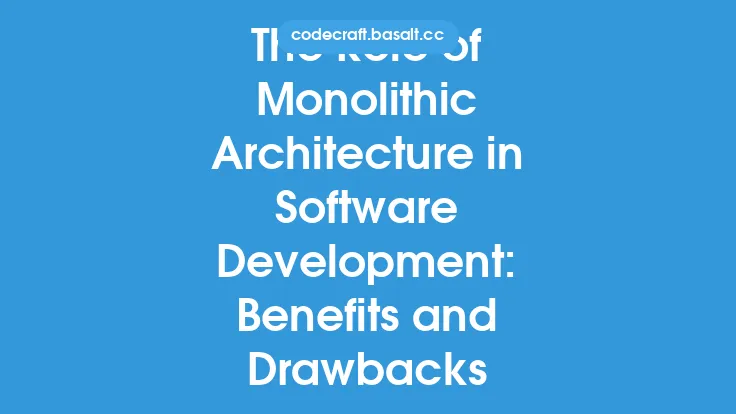The monolithic architecture pattern is a traditional and widely used approach to software development, where a single, self-contained unit comprises the entire application. This unit, often referred to as a monolith, encompasses all the components, features, and functionalities of the software, making it a cohesive and unified whole. In this article, we will delve into the intricacies of the monolithic architecture pattern, exploring its underlying principles, advantages, and challenges.
History and Evolution
The monolithic architecture pattern has its roots in the early days of software development, when applications were relatively simple and small in scale. As software complexity grew, so did the need for more organized and maintainable architectures. The monolithic pattern emerged as a natural response to this need, providing a straightforward and intuitive way to structure software applications. Over time, the monolithic pattern has evolved to accommodate changing technology landscapes, programming paradigms, and development methodologies. Despite the rise of alternative architectures, such as microservices and modular designs, the monolithic pattern remains a popular choice for many software projects.
Key Characteristics
A monolithic architecture is characterized by several key features, including a single, unified codebase, a self-contained deployment unit, and a tightly coupled internal structure. The single codebase means that all the application's components, features, and functionalities are contained within a single repository, making it easier to manage and maintain. The self-contained deployment unit implies that the entire application is deployed as a single entity, simplifying the deployment process and reducing the complexity of managing multiple deployment units. The tightly coupled internal structure, on the other hand, means that the various components and features of the application are highly interconnected, making it challenging to modify or replace individual components without affecting the entire system.
Technical Implementation
From a technical perspective, a monolithic architecture typically involves a single process or thread that executes the entire application. This process or thread is responsible for handling all incoming requests, processing business logic, and interacting with external systems, such as databases or file systems. The application's components and features are often organized into a hierarchical structure, with each component or feature building upon the previous one. This hierarchical structure can make it easier to navigate and understand the application's codebase, but it can also lead to a rigid and inflexible architecture. In terms of programming languages and frameworks, monolithic architectures can be implemented using a wide range of technologies, including Java, Python, C#, and Ruby on Rails.
Advantages and Challenges
The monolithic architecture pattern offers several advantages, including simplicity, ease of development, and faster time-to-market. The unified codebase and self-contained deployment unit make it easier to develop, test, and deploy monolithic applications, reducing the complexity and overhead associated with managing multiple deployment units. Additionally, the tightly coupled internal structure can provide better performance and responsiveness, as the various components and features are highly optimized for each other. However, the monolithic pattern also presents several challenges, including scalability limitations, maintainability issues, and a higher risk of technical debt. As the application grows in size and complexity, the monolithic architecture can become increasingly difficult to maintain, modify, and scale, leading to a higher risk of technical debt and decreased overall quality.
Comparison with Other Architectures
In comparison to other architectures, such as microservices or modular designs, the monolithic pattern offers a more traditional and straightforward approach to software development. Microservices architectures, for example, involve breaking down the application into smaller, independent services that communicate with each other using APIs or messaging systems. This approach provides greater flexibility, scalability, and maintainability, but it also introduces additional complexity and overhead. Modular designs, on the other hand, involve organizing the application into smaller, self-contained modules that can be developed, tested, and deployed independently. This approach provides a balance between the monolithic and microservices architectures, offering greater flexibility and maintainability while minimizing the complexity and overhead associated with microservices.
Real-World Applications
The monolithic architecture pattern is widely used in many real-world applications, including web applications, mobile apps, and desktop software. For example, many e-commerce platforms, such as Shopify or Magento, use a monolithic architecture to provide a unified and cohesive user experience. Similarly, many mobile apps, such as social media or gaming apps, use a monolithic architecture to provide fast and responsive performance. In the desktop software domain, many applications, such as Microsoft Office or Adobe Creative Cloud, use a monolithic architecture to provide a rich and feature-rich user experience.
Best Practices and Recommendations
To get the most out of the monolithic architecture pattern, it is essential to follow best practices and recommendations. These include keeping the codebase organized and maintainable, using a modular and hierarchical structure, and minimizing technical debt. Additionally, it is crucial to monitor the application's performance and scalability, making adjustments and optimizations as needed. Finally, it is essential to consider the trade-offs and limitations of the monolithic pattern, weighing the benefits against the potential drawbacks and challenges. By following these best practices and recommendations, developers can create high-quality, maintainable, and scalable monolithic applications that meet the needs of users and stakeholders.
Conclusion
In conclusion, the monolithic architecture pattern is a traditional and widely used approach to software development, offering a unified and cohesive way to structure software applications. While it presents several advantages, including simplicity and ease of development, it also introduces challenges, such as scalability limitations and maintainability issues. By understanding the underlying principles, advantages, and challenges of the monolithic pattern, developers can make informed decisions about when to use it and how to implement it effectively. As software development continues to evolve, the monolithic architecture pattern remains a relevant and important part of the software development landscape, providing a foundation for building high-quality, maintainable, and scalable software applications.





